Finding the least common multiple (LCM) is a fundamental mathematical operation with applications in fractions, problem-solving, and various real-world scenarios. Our Least Common Multiple Calculator simplifies this process, allowing you to find the LCM of two or more numbers instantly. Whether you’re a student tackling math homework, a teacher preparing lessons, or a professional needing quick calculations, understanding LCM and having access to a reliable calculator can save you valuable time and prevent errors.
What is Least Common Multiple (LCM)?
The Least Common Multiple (LCM) of two or more numbers is the smallest positive integer that is divisible by each of those numbers without leaving a remainder. In other words, it’s the smallest number that is a multiple of all the given numbers.
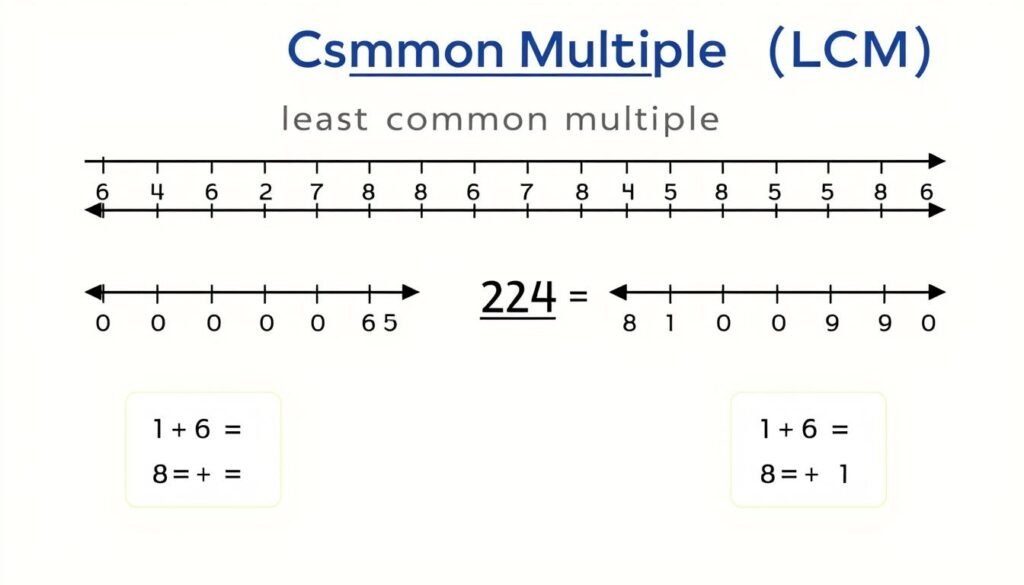
The LCM is the smallest number that appears in all sets of multiples
For example, the LCM of 4 and 6 is 12 because:
- Multiples of 4: 4, 8, 12, 16, 20, 24, …
- Multiples of 6: 6, 12, 18, 24, 30, …
- The smallest number that appears in both lists is 12.
Similarly, the LCM of 3, 5, and 7 would be 105, as it’s the smallest number divisible by all three numbers.
How to Calculate LCM
There are several methods to calculate the least common multiple of numbers. Each approach has its advantages depending on the specific numbers you’re working with. Let’s explore the most common methods:
1. Prime Factorization Method
This method involves breaking down each number into its prime factors and then multiplying the highest powers of each prime factor.
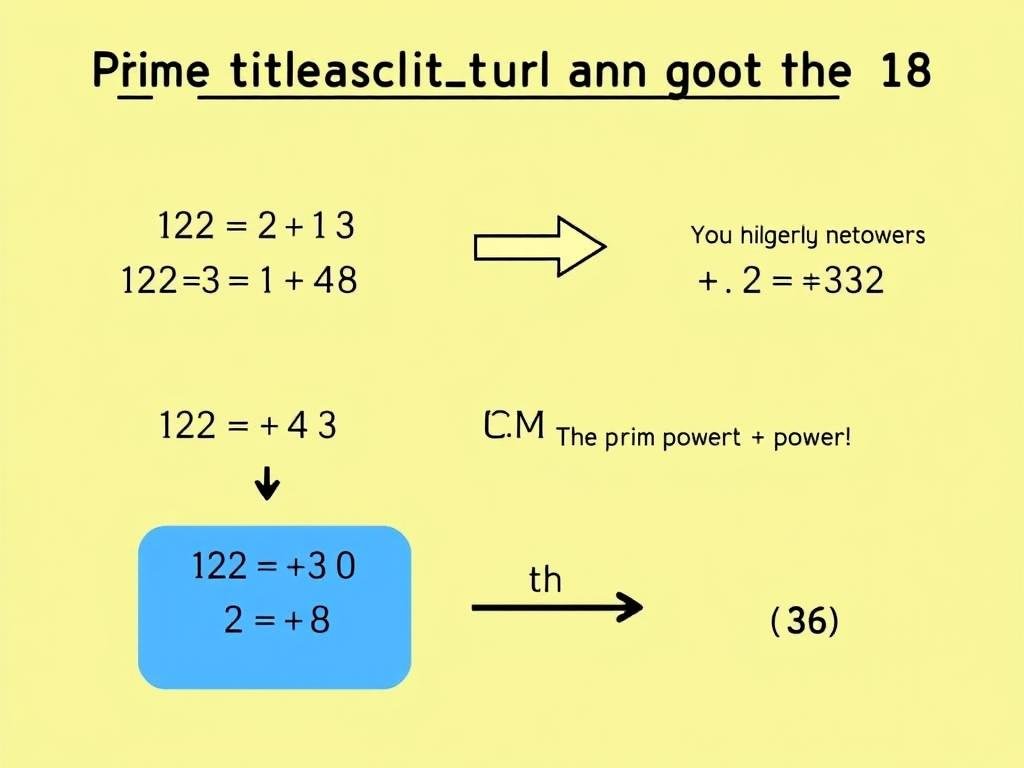
Prime factorization method for finding LCM
Example: Find the LCM of 12 and 18 using prime factorization
- Find the prime factorization of each number:
- 12 = 2² × 3
- 18 = 2 × 3²
- Identify all prime factors: 2 and 3
- Take each prime factor to its highest power:
- 2 appears with power 2 in 12 and power 1 in 18, so take 2²
- 3 appears with power 1 in 12 and power 2 in 18, so take 3²
- Multiply these factors: 2² × 3² = 4 × 9 = 36
- Therefore, LCM(12, 18) = 36
2. Listing Multiples Method
This is the most straightforward method, especially for smaller numbers. Simply list the multiples of each number until you find the smallest common multiple.
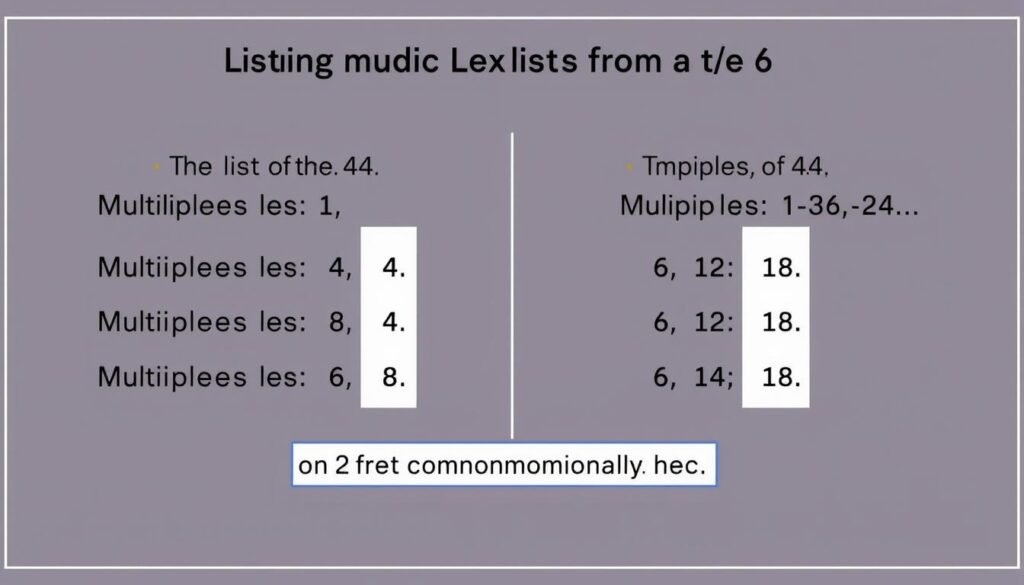
Finding LCM by listing multiples
Example: Find the LCM of 5 and 7 using listing multiples
- List the multiples of 5: 5, 10, 15, 20, 25, 30, 35, 40, …
- List the multiples of 7: 7, 14, 21, 28, 35, 42, …
- Identify the smallest number that appears in both lists: 35
- Therefore, LCM(5, 7) = 35
3. Division Method (Ladder Method)
Also known as the cake method or ladder method, this approach uses division by prime numbers to find the LCM.

Division method (ladder method) for finding LCM
Example: Find the LCM of 10, 15, and 25 using the division method
- Arrange the numbers in a row: 10, 15, 25
- Divide by the smallest prime number that divides at least one of the numbers:
- Divide by 2: 5, 15, 25 (only 10 is divisible by 2)
- Continue dividing:
- Divide by 5: 1, 3, 5 (all numbers are divisible by 5)
- Divide by 3: 1, 1, 5 (only 3 is divisible by 3)
- Divide by 5: 1, 1, 1 (only 5 is divisible by 5)
- Multiply all the divisors: 2 × 5 × 3 × 5 = 150
- Therefore, LCM(10, 15, 25) = 150
4. Using the Greatest Common Divisor (GCD)
This method uses the relationship between LCM and GCD: LCM(a,b) = (a × b) ÷ GCD(a,b)

Using GCD to find LCM
Example: Find the LCM of 24 and 36 using GCD
- Find the GCD of 24 and 36:
- Using the Euclidean algorithm: GCD(24, 36) = 12
- Apply the formula: LCM(a,b) = (a × b) ÷ GCD(a,b)
- LCM(24, 36) = (24 × 36) ÷ 12 = 864 ÷ 12 = 72
- Therefore, LCM(24, 36) = 72
Practical Applications of LCM
The least common multiple has numerous practical applications in mathematics and real-world scenarios:

Real-world applications of LCM
Working with Fractions
When adding or subtracting fractions with different denominators, you need to find a common denominator. The LCM of the denominators is the most efficient choice.
For example, to add 1/4 + 1/6, you would find LCM(4,6) = 12, then convert to 3/12 + 2/12 = 5/12.
Scheduling and Planning
LCM helps determine when recurring events will coincide. If one event occurs every 3 days and another every 5 days, they will coincide every LCM(3,5) = 15 days.
This is useful for maintenance schedules, shift rotations, and planning recurring meetings.
Engineering Applications
In mechanical engineering, LCM helps determine when gear teeth will align in the same position. If one gear has 8 teeth and another has 12 teeth, they will return to their starting position after LCM(8,12) = 24 rotations.
Pattern Recognition
LCM helps identify when patterns will repeat. For instance, if you have two sequences with periods of 4 and 6, the combined pattern will repeat after LCM(4,6) = 12 steps.
Why Use Our LCM Calculator?
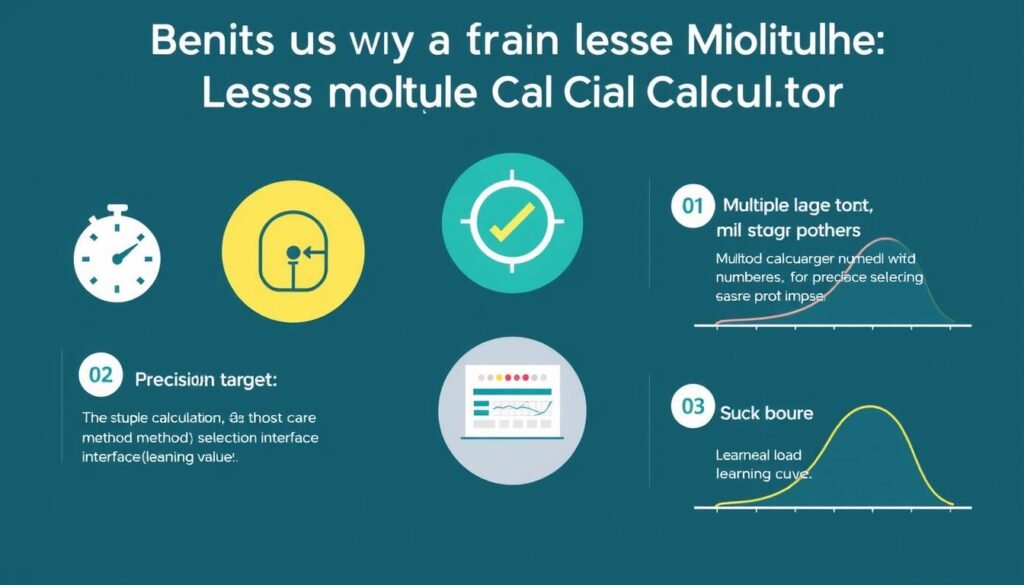
Benefits of using our LCM calculator
- Instant results for any set of numbers, saving valuable time
- 100% accuracy, eliminating human calculation errors
- Handles large numbers that would be tedious to calculate manually
- Shows step-by-step solutions for educational purposes
- Supports multiple calculation methods to match your preference
- Works with both small and large sets of numbers
- Available anytime, anywhere with internet access
Advantages of Our LCM Calculator
Ready to Simplify Your LCM Calculations?
Our Least Common Multiple Calculator handles all the complex math for you, providing instant, accurate results for any set of numbers.
Common LCM Problems & Solutions
Let’s solve some typical least common multiple problems to demonstrate how our calculator can help:
Problem 1: LCM of Three Numbers
Question: Find the LCM of 12, 18, and 24.
Solution:
- Find the prime factorization of each number:
- 12 = 2² × 3
- 18 = 2 × 3²
- 24 = 2³ × 3
- Take the highest power of each prime factor:
- Highest power of 2: 2³ (from 24)
- Highest power of 3: 3² (from 18)
- Multiply these factors: 2³ × 3² = 8 × 9 = 72
- Therefore, LCM(12, 18, 24) = 72

Step-by-step solution for finding LCM of three numbers
Problem 2: LCM in a Word Problem
Question: Two buses leave the station at the same time. One bus returns every 30 minutes, while the other returns every 45 minutes. After how many minutes will both buses return to the station at the same time?
Solution:
- We need to find LCM(30, 45)
- Prime factorization:
- 30 = 2 × 3 × 5
- 45 = 3² × 5
- Highest powers: 2, 3², and 5
- LCM = 2 × 3² × 5 = 2 × 9 × 5 = 90
- Therefore, both buses will return to the station together after 90 minutes.
Problem 3: LCM for Fraction Addition
Question: Add the fractions 2/15 + 7/20 + 1/6
Solution:
- Find the LCM of the denominators: 15, 20, and 6
- Prime factorization:
- 15 = 3 × 5
- 20 = 2² × 5
- 6 = 2 × 3
- Highest powers: 2², 3, and 5
- LCM = 2² × 3 × 5 = 4 × 3 × 5 = 60
- Convert each fraction to an equivalent fraction with denominator 60:
- 2/15 = 8/60
- 7/20 = 21/60
- 1/6 = 10/60
- Add the numerators: 8 + 21 + 10 = 39
- Therefore, 2/15 + 7/20 + 1/6 = 39/60 = 13/20 (simplified)
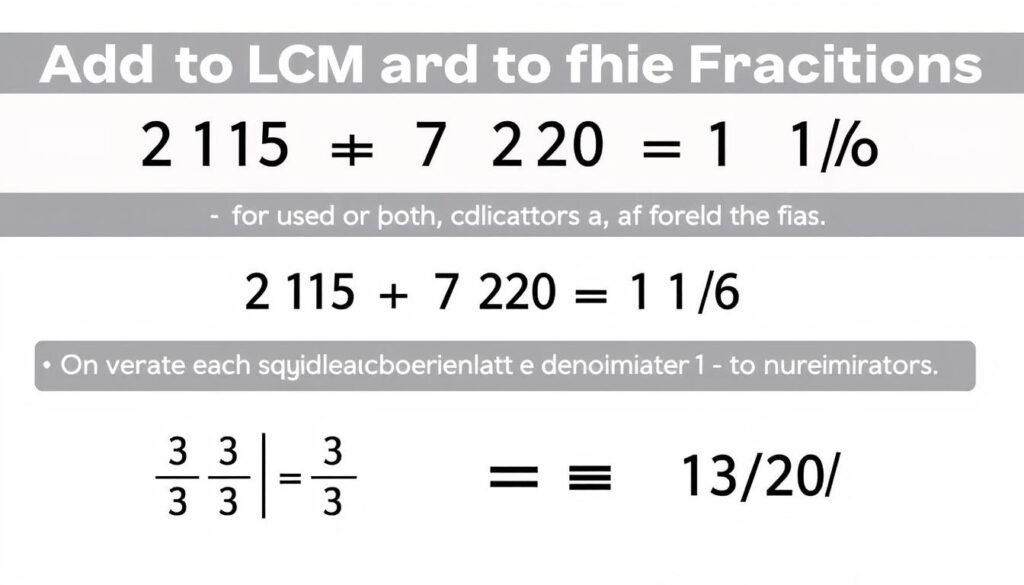
Using LCM to add fractions with different denominators
Frequently Asked Questions
What is the LCM of two numbers?
The LCM (Least Common Multiple) of two numbers is the smallest positive integer that is divisible by both numbers without a remainder. For example, the LCM of 4 and 6 is 12, as it’s the smallest number that both 4 and 6 can divide into evenly.
How do you find LCM quickly?
The fastest way to find the LCM is using the formula: LCM(a,b) = (a × b) ÷ GCD(a,b), where GCD is the Greatest Common Divisor. For multiple numbers, you can find the LCM of the first two numbers, then find the LCM of that result and the next number, and so on. Using our Least Common Multiple Calculator is the quickest method for any set of numbers.
What is the difference between LCM and GCD?
The Least Common Multiple (LCM) is the smallest number that is divisible by all given numbers, while the Greatest Common Divisor (GCD) is the largest number that divides all given numbers without a remainder. For example, for 12 and 18, the LCM is 36 and the GCD is 6. They are related by the formula: LCM(a,b) × GCD(a,b) = a × b.
Can LCM be calculated for more than two numbers?
Yes, the LCM can be calculated for any number of integers. You can either find the LCM of the first two numbers, then find the LCM of that result and the third number, and so on. Alternatively, you can use the prime factorization method by taking the highest power of each prime factor that appears in any of the numbers.
Why is LCM important in mathematics?
LCM is crucial in mathematics for several reasons: it’s essential for adding and subtracting fractions with different denominators, solving problems involving cycles and patterns, determining when recurring events will coincide, and in various applications in algebra, number theory, and real-world problem-solving. Understanding LCM helps simplify complex mathematical operations and solve practical problems efficiently.
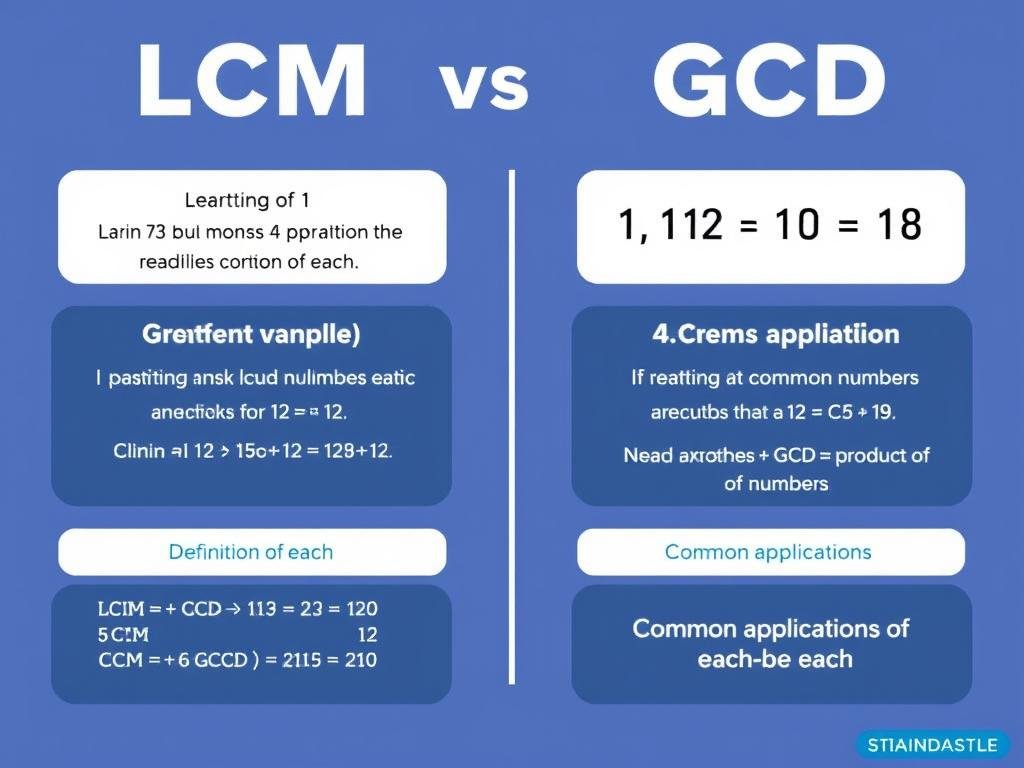
Comparison between LCM and GCD concepts
Conclusion
The Least Common Multiple is a fundamental mathematical concept with wide-ranging applications in both academic and practical contexts. Whether you’re working with fractions, solving scheduling problems, or tackling complex mathematical equations, understanding how to calculate LCM efficiently is essential.
While there are several methods to find the LCM manually, using our Least Common Multiple Calculator provides the fastest, most accurate results without the risk of calculation errors. Our calculator supports multiple calculation methods, works with any set of numbers, and provides step-by-step solutions to help you understand the process.
Save Time on Your LCM Calculations
Why spend time on manual calculations when you can get instant, accurate results? Try our Least Common Multiple Calculator today and simplify your mathematical tasks.